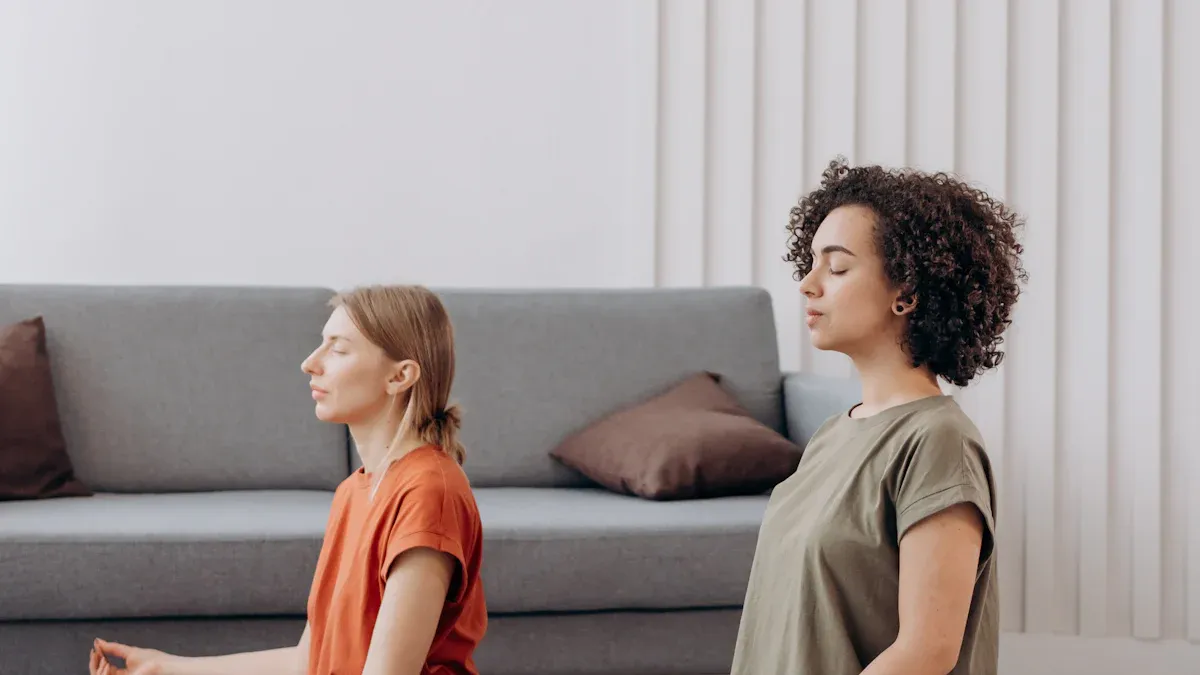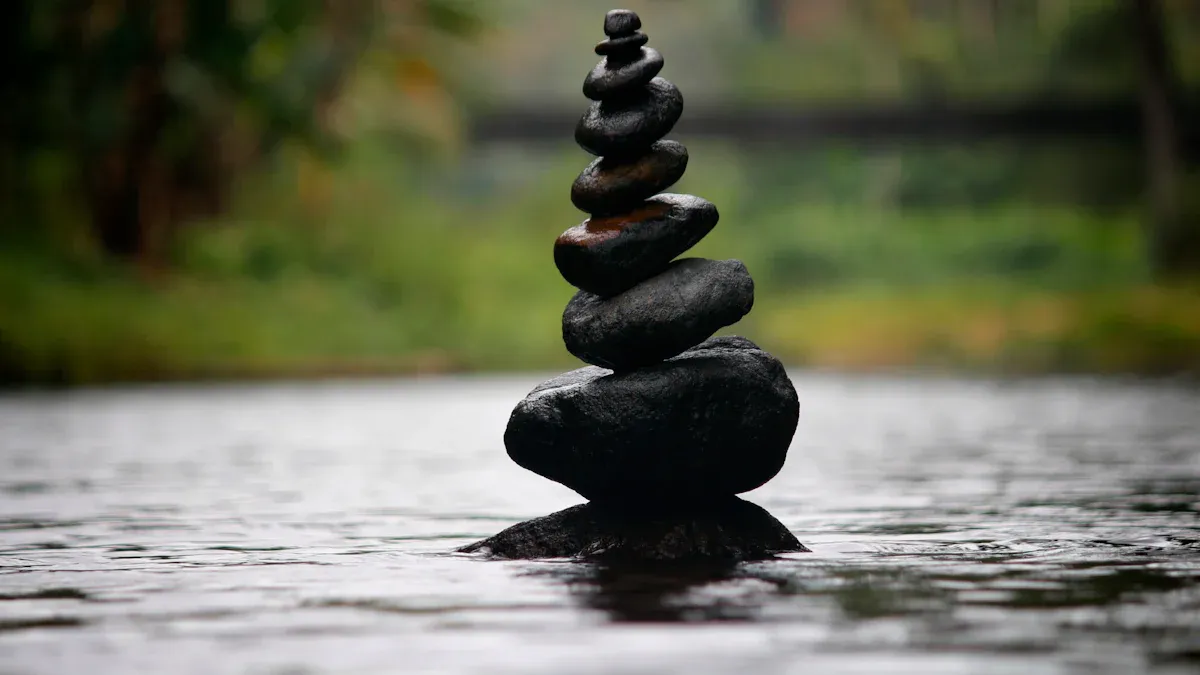Finding Harmony Between Rest and Activity

Finding the right balance between rest and activity is like tuning an instrument. When you get it right, your body and mind work in harmony. But when things are off, you might feel drained, anxious, or even physically unwell. Did you know your body has two systems—the sympathetic and parasympathetic—that control stress and recovery? Too much stress activates the "fight or flight" mode, leaving you exhausted. Restorative activities, like sleep or relaxation, help your body heal and recharge.
Start paying attention to how you spend your time. Small changes can make a big difference. Balancing Rest and Activity: A Survivor's Guide can help you take that first step toward a healthier, happier you.
Key Takeaways
Mix rest and activity to improve your body and mind. Both are key to staying active and alert.
Pay attention to your body. Change your habits if you feel tired or overworked to stay healthy.
Add small breaks and easy tasks to your day. Little changes can make you feel much better.
Make good sleep a priority. Try to sleep 7-9 hours every night to help your body and mind recover.
Use planners or apps to plan rest and activities. Being regular helps keep your life balanced.
Balancing Rest and Activity: A Survivor's Guide
What Does Balance Look Like?
The interplay between rest and activity
Finding balance between rest and activity is like walking a tightrope. You need both to stay steady. Rest gives your body and mind the chance to recover, while activity keeps you energized and strong. Think of it as a cycle—rest refuels you for activity, and activity helps you sleep better at night. When these two work together, you feel more in control of your energy and emotions.
Young childhood cancer survivors have shared how they managed fatigue by learning to listen to their bodies. They adjusted their activities when they felt tired and leaned on family and friends for support. This approach helped them avoid overdoing it while staying socially active. You can do the same by tuning into your body’s signals and making small adjustments to your daily routine.
Why balance is key to mental and physical health
Balance isn’t just about feeling good—it’s essential for your health. Adequate rest improves your focus, mood, and overall well-being. On the flip side, staying active strengthens your body and reduces the risk of chronic illnesses. Together, rest and activity create a foundation for a healthier, happier life.
The Risks of Imbalance
Consequences of excessive rest
Too much rest can leave you feeling sluggish and unmotivated. It’s like staying in bed all day—you might feel rested at first, but eventually, you’ll notice your energy levels dropping. Insufficient activity can also lead to physical issues like muscle weakness and poor circulation.
Consequences of excessive activity
Overdoing it with activity can be just as harmful. Chronic stress from constant activity can lead to fatigue, depression, and anxiety. In fact:
79% of employees reported work-related stress in a recent survey.
26% said they lacked energy or motivation due to stress.
44% experienced physical fatigue, a significant increase since 2019.
"We’ve known people in these occupations have always had higher rates of burnout, but it’s been so much harder to keep up with the demands during a pandemic in caretaking professions." - Christina Maslach, PhD
Ignoring the need for rest can result in burnout, emotional exhaustion, and even physical injuries. Finding balance is the key to avoiding these pitfalls.
The Power of Rest

Rest as a Foundation for Recovery
How rest supports physical repair and mental clarity
Rest isn’t just about lying down; it’s your body’s way of hitting the reset button. When you rest, your body focuses on repairing tissues, building energy, and clearing out toxins. It’s like giving your car a tune-up so it runs smoothly. Studies even show that animals recover faster when they get proper sleep during illness. On the flip side, pushing through sickness or fatigue can slow recovery and worsen conditions like the flu.
Your mind benefits just as much as your body. Rest clears mental fog and sharpens your focus. It’s why you often feel more creative or productive after a good night’s sleep. So, the next time you’re tempted to skip rest, remember—it’s not laziness; it’s self-care.
The role of quality sleep in overall health
Sleep is the MVP of rest. It’s when your body does its best work, like repairing muscles and consolidating memories. Poor sleep can lead to a weakened immune system, mood swings, and even long-term health issues. Aim for 7-9 hours of quality sleep each night. Create a bedtime routine, like dimming the lights or reading a book, to signal your body that it’s time to wind down.
Relaxation Techniques for Mental Health
Mindfulness and meditation practices
Mindfulness and meditation are like mental workouts. They help you stay present and reduce stress. Research shows that mindfulness-based therapies can lower anxiety, depression, and even physical pain. Over 200 studies confirm that these practices are effective for mental health. You don’t need to spend hours meditating—a few minutes a day can make a big difference. Apps like Headspace or Calm can guide you if you’re unsure where to start.
Breathing exercises for stress relief
Feeling overwhelmed? Take a deep breath. Breathing exercises are simple yet powerful tools for calming your mind. Try the 4-7-8 technique: inhale for 4 seconds, hold for 7, and exhale for 8. This slows your heart rate and reduces stress. It’s like hitting the pause button on your worries.
Emotional Benefits of Rest
Reducing anxiety and enhancing focus
Rest isn’t just physical—it’s emotional too. Taking breaks can lower anxiety and help you regain focus. When you’re constantly on the go, your brain struggles to keep up. Short mental health breaks, like stepping outside or listening to music, can recharge your mind and improve your mood.
The importance of mental health breaks
Think of mental health breaks as pit stops during a race. They keep you from burning out and help you perform better in the long run. Whether it’s a quick walk, a nap, or just sitting quietly, these moments of rest are essential. Don’t feel guilty about taking them—they’re an investment in your well-being.
Remember, balancing rest and activity is a journey, not a destination. Small changes, like adding mindfulness or prioritizing sleep, can lead to big improvements in your health and happiness.
The Benefits of Activity

Physical Advantages of Staying Active
Strengthening the body and boosting energy levels
Staying active isn’t just about looking fit—it’s about feeling strong and energized. When you move your body, your muscles grow stronger, and your stamina improves. Even simple activities like walking or dancing can boost your energy levels. Think of exercise as fuel for your body. It keeps you going throughout the day and helps you tackle challenges with more ease.
Preventing chronic illnesses through regular exercise
Regular physical activity is like a shield for your health. It lowers the risk of serious illnesses like heart disease, diabetes, and even some cancers. Studies show that even less than 150 minutes of moderate exercise a week can make a difference. For cancer survivors, staying active improves quality of life and physical fitness. By moving more, you’re not just living longer—you’re living better.
Mental Health Boosts from Activity
Exercise as a natural stress reliever
Feeling stressed? Exercise can help. Physical activity releases endorphins, your body’s natural mood boosters. These chemicals reduce stress and leave you feeling more relaxed. Even a quick workout can calm your mind and improve your focus.
Moderate to vigorous exercise can reduce anxiety almost immediately.
Long-term exercise habits lower the risk of depression.
The link between physical activity and improved mood
Exercise doesn’t just relieve stress—it makes you happier. Research involving over 191,000 participants found that regular activity significantly reduces the risk of depression. Even small amounts of movement, like walking for an hour or running for 15 minutes a day, can improve your mood. You don’t need to be a marathon runner to feel the benefits. Every step counts.
Choosing the Right Activities
Aerobic exercises for cardiovascular health
Aerobic exercises, like jogging, swimming, or cycling, are great for your heart. They improve blood flow, strengthen your cardiovascular system, and increase endurance. If you’re new to exercise, start with brisk walking or light jogging. These activities are easy to fit into your routine and offer big health benefits.
Strength and flexibility training (e.g., yoga, pilates)
Strength and flexibility exercises, like yoga or pilates, help build muscle and improve balance. These activities also enhance flexibility, reducing the risk of injuries. Plus, they’re great for mental health. Yoga, for example, combines movement with mindfulness, giving you both physical and emotional benefits.
Tip: Choose activities you enjoy. Whether it’s dancing, hiking, or playing a sport, finding something fun makes it easier to stick with your routine.
Practical Strategies for Balancing Rest and Activity
Building a Balanced Routine
Scheduling time for rest and activity
Creating a balanced routine starts with scheduling. Think of your day as a puzzle where rest and activity are the key pieces. Block out time for both, just like you would for work or appointments. For example, set aside 30 minutes in the morning for a walk and an hour in the evening to unwind with a book or meditation.
A well-planned schedule helps you stay consistent. Customize it to fit your needs. Focus on high-impact activities first, then sprinkle in breaks to recharge. Regularly review your routine and adjust it as life changes. Reflection at the end of the day can also help you improve your schedule over time.
Using tools like planners or apps for consistency
Planners and apps can be your best friends when it comes to staying on track. Use a physical planner if you enjoy writing things down, or try apps like Google Calendar or Notion for digital convenience. These tools can remind you to take breaks, exercise, or even get to bed on time. Consistency is easier when you have a system in place.
Listening to Your Body’s Needs
Recognizing signs of fatigue or overexertion
Your body sends signals when it needs rest or activity. Feeling sluggish or unmotivated? That’s your cue to move. On the other hand, if you’re constantly tired or sore, it’s time to slow down. Pay attention to these signs. They’re your body’s way of keeping you balanced.
Adjusting your routine based on physical and mental cues
Flexibility is key. If you notice fatigue creeping in, swap a high-intensity workout for a gentle yoga session. If you’re feeling restless, take a brisk walk instead of sitting on the couch. Balancing rest and activity means adapting to what your body and mind need in the moment. This approach helps you stay energized and avoid burnout.
Integrating Rest and Activity Seamlessly
Active rest options (e.g., walking, light stretching)
Active rest is a game-changer. It combines movement with relaxation, giving your body a chance to recover while staying engaged. Activities like walking, light stretching, or even dancing can help you recharge without feeling lazy. Spending time in nature or with loved ones can also provide a soothing break.
Prioritizing rest without guilt
Rest is not a luxury—it’s a necessity. Taking breaks doesn’t mean you’re slacking off. It’s an investment in your well-being. Whether it’s a quick nap, a few deep breaths, or a weekend getaway, prioritize rest without guilt. Remember, balancing rest and activity is about finding harmony, not perfection.
"To optimize energy levels, balance periods of activity with deep rest and relaxation. This allows your body to recover and rejuvenate, enhancing your overall well-being."
Balancing Rest and Activity: A Survivor's Guide emphasizes the importance of listening to your body and integrating rest and activity into your daily life. By doing so, you’ll feel more energized, focused, and ready to take on whatever comes your way.
Examples of Balanced Daily Routines
A sample weekday routine for balance
Creating a balanced weekday routine doesn’t have to be complicated. It’s all about finding a rhythm that works for you. Here’s an example to get you started:
Morning (6:30 AM - 9:00 AM):
Wake up and spend a few minutes stretching or practicing mindfulness. Enjoy a healthy breakfast and plan your day. If possible, take a short walk to energize yourself.Midday (12:00 PM - 1:00 PM):
Take a break from work or school. Eat a nutritious lunch and step outside for fresh air. Even a 10-minute walk can boost your mood and focus.Afternoon (3:00 PM - 5:00 PM):
Schedule time for light physical activity, like yoga or a quick workout. This helps you stay active without overexerting yourself.Evening (7:00 PM - 9:30 PM):
Wind down with a calming activity, like reading or listening to music. Avoid screens before bed to improve sleep quality. Aim for 7-8 hours of sleep to recharge for the next day.
Tip: Prioritize downtime to prevent burnout. Soothing activities, like journaling or meditation, can help you relax and reduce stress.
Adapting routines for weekends or busy schedules
Weekends and hectic days call for flexibility. You can still maintain balance by adjusting your routine to fit your needs.
On weekends, focus on activities that bring you joy. Spend time with loved ones or engage in hobbies. Childhood cancer survivors often prioritized social connections to stay emotionally balanced. You can do the same by setting aside time for friends or family.
During busy schedules, simplify your routine. Swap intense workouts for light stretching or a short walk. If you’re feeling overwhelmed, take a few minutes to breathe deeply or meditate.
Remember, balance isn’t about perfection. It’s about listening to your body and making small adjustments to stay energized and stress-free.
Balancing rest and activity is the key to a healthier, happier life. When you find harmony, your body and mind thrive. Here’s why it matters:
It balances your nervous system, reducing stress and boosting energy.
Rest renews your strength, while activity keeps you fit and focused.
Together, they improve mental clarity, emotional well-being, and physical health.
Start small. Take breaks, move your body, and listen to what it needs. Remember, this is your journey. Every step toward balance brings you closer to a more vibrant, fulfilling life. 🌟
FAQ
How do I know if I’m overdoing it with activity?
Pay attention to your body. If you feel constantly tired, sore, or irritable, you might be pushing too hard. Take a step back and allow yourself time to rest. Balance is about listening to what your body needs.
What’s the best way to start balancing rest and activity?
Start small. Add short breaks to your day and include light activities like walking. Use a planner or app to schedule both rest and movement. Adjust as you go to find what works best for you.
Can I combine rest and activity?
Absolutely! Active rest, like stretching or a leisurely walk, lets you recharge while staying lightly active. It’s a great way to integrate both into your routine without feeling overwhelmed.
How much sleep do I really need?
Most adults need 7-9 hours of quality sleep each night. Create a calming bedtime routine to help you wind down. Avoid screens before bed and keep your sleep environment quiet and comfortable.
What if I feel guilty about resting?
Rest is essential, not indulgent. Think of it as fuel for your body and mind. Taking breaks helps you stay productive and healthy. Remind yourself that rest is an investment in your well-being.
Tip: Balance isn’t about perfection. It’s about finding what works for you and making small, consistent changes.
See Also
Discover Banish Cancer – A Place for Hope and Strength
An Overview of Chronic Lymphocytic Leukemia Explained
Exploring Symptoms and Treatments for Lymphomatoid Granulomatosis
